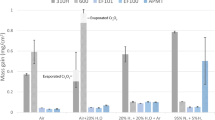Abstract
An investigation of the mechanism of gaseous carburization in a reducing environment was conducted for selected Fe- and Ni-base alloys. Carburization kinetics were measured as functions of temperature in the range 870–980 °C. Scanning electron microscopy, analytical electron microscopy and X-ray diffractometry were employed for microstructural characterization and microchemical analysis. Changes in mechanical strength produced by carburization were determined from microhardness and tensile property measurements. Kinetic studies indicated that the carburization reaction followed a parabolic rate law. Depending upon the nature of surface scale formed in the presence of a carburizing environment, the rate-determining step of the reaction varied from C diffusion into the alloy in the presence of a carbide scale to that in the presence of an oxide scale. Under reducing carburizing conditions, alloys inherently protected by Cr2O3-base scale were found to develop a surface carbide scale which allowed C to penetrate into the alloy with relative ease and, thus, the carburization kinetics was accelerated. In contrast, an alloy capable of forming Al2O3 developed and maintained a protective surface oxide scale which acted as an effective barrier to C diffusion into the alloy. Degradation of mechanical strength due to precipitation of carbides in the alloy was correlated with the rate of attack and consequently the nature of the surface scale.
Similar content being viewed by others
References
J. Norton (coordinator), “Carburization in High Temperature Process Plant Materials”, Colloquium Proceedings (Commission of the European Communities, BP 1003, Luxembourg, 1981).
J. Blackburn,Mater. Perform. 16 (12) (1977) 24.
G. Y. Lai, M. F. Rothman andD. E. Fluck,Industr. Heating (August 1985).
G. Y. Lai, in “High Temperature Corrosion in Energy Systems”, edited by M. F. Rothman (TMS-AIME, Warrendale, Pennsylvania, 1985) p. 564.
G. Y. Lai andM. F. Rothman, in “Corrosion 84” (National Association of Corrosion Engineers, New Orleans, Houston, Texas, 1984) Paper No. 11.
G. M. Smith, D. J. Young andD. L. Trimm,Oxid. Met. 18 (5/6) (1982) 229.
J. M. Harrison, J. F. Norton, R. T. Derricott andJ. B. Marriott,Werkst. Korros. 30 (1979) 785.
J. F. Norton, L. Blidegen, S. Canetoli andP. D. Frampton,ibid. 32 (1981) 467.
A. Schnaas andH. J. Grabke,Oxid. Met. 12 (5) (1978) 387.
I. M. Harrison andJ. F. Norton, in “Behavior of High Temperature Alloys in Aggressive Environments”, edited by I. Kirman, J. B. Marriott, M. Merz, R. R. Sahm and D. P. Whittle (Metals Society, London, 1980) p. 661.
E. Bullock, P. D. Frampton andJ. F. Norton, in “Microstructural Science”, Vol. 9, edited by Gunter Petzow, R. Paris, E. D. Albrecht and J. A. McCall (Elsevier NorthHolland, New York, -1981) p. 261.
G. H. Meier, W. C. Coons andR. A. Perkins,Oxid. Met. 18 (3/4) (1982) 235.
R. A. Perkins, in “Behavior of High Temperature Alloys in Aggressive Environments”, edited by I. Kirman, J. B. Marriott, M. Merz, R. R. Sahm and D. P. Whittle (Metals Society, London, 1980) p. 617.
O. Van der Biest, J. M. Harrison andJ. F. Norton,ibid.in “ p. 681.
G. Y. Lai andR. A. Johnson, “Carburization ofAustenitic Alloys by Gaseous Impurities in Helium”, DOE Report GA-A 15790 (General Atomic Company, San Diego, CA, 1980).
R. B. Herchenroeder, G. Y. Lai andK. V. Rao,J. Metals 35 (11) (1983) 16.
H. J. Grabke andA. Schnass, in “Alloy 800”, edited by W. Betteridgeet al. (North-Holland, Amsterdam, 1978) p. 195.
J. K. Stanley,J. Mater. 5 (1970) 957.
K. Natesan andT. F. Kassner,Met. Trans. 4 (1973) 2557.
J. C. Greenbank,J. Iron Steel Inst. 210 (1972) 111.
L. L. Shreir, “Corrosion”, (Metal Society London, 1976) p. 798.
J. W. Edington, “Practical Electron Microscopy in Materials Science”, Vol. 4 (Philips, Eindhoven, 1976) p. 33.
R. F. Decker andC. T. Sims, in “The Superalloys”, edited by C. T. Sims and W. C. Hagel (Wiley, New York, 1972) p. 52.
A. W. Searcy, in “Chemical and Mechanical Behavior of Inorganic Materials”, edited by A. W. Searcy, D. V. Ragone and U. Columbo (Wiley-Interscience, New York, 1970) p. 33.
Author information
Authors and Affiliations
Rights and permissions
About this article
Cite this article
Tawancy, H.M., Abbas, N.M. Mechanism of carburization of high-temperature alloys. J Mater Sci 27, 1061–1069 (1992). https://doi.org/10.1007/BF01197661
Received:
Accepted:
Issue Date:
DOI: https://doi.org/10.1007/BF01197661




